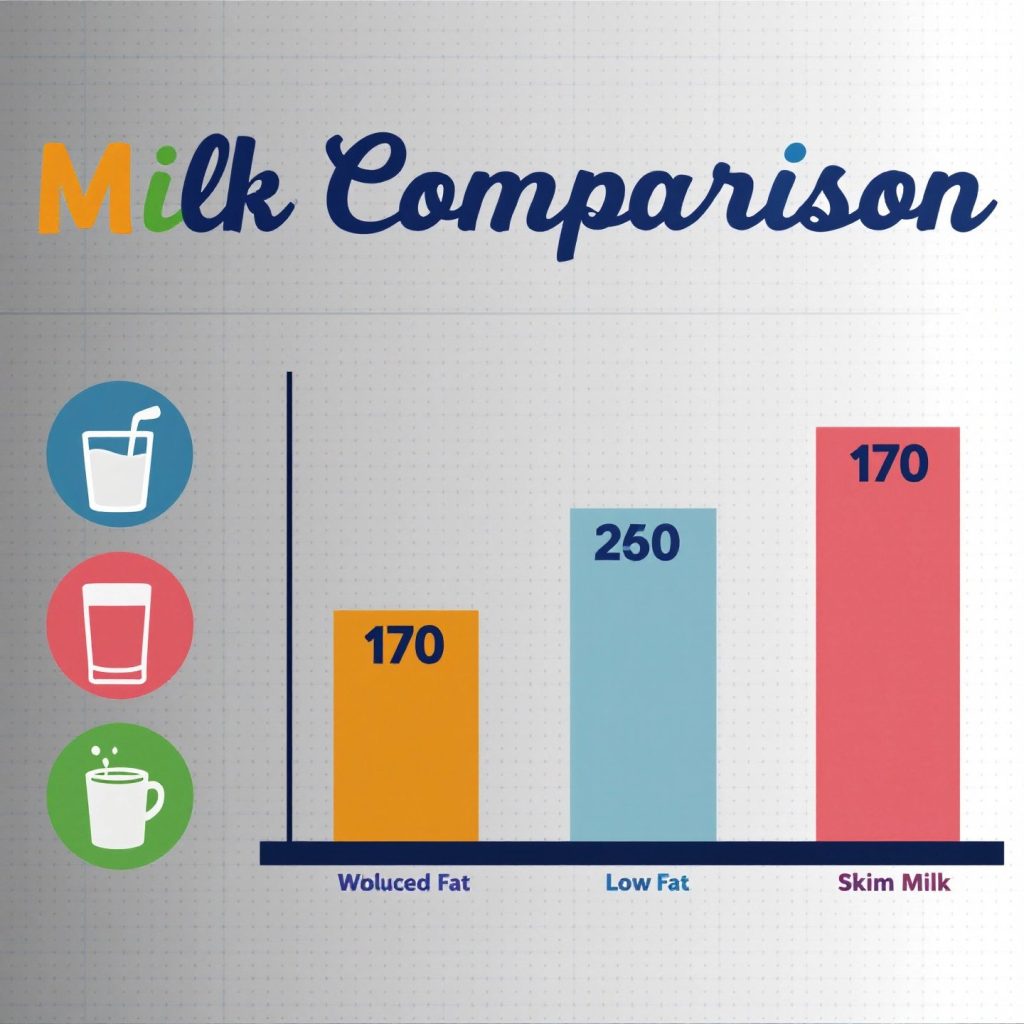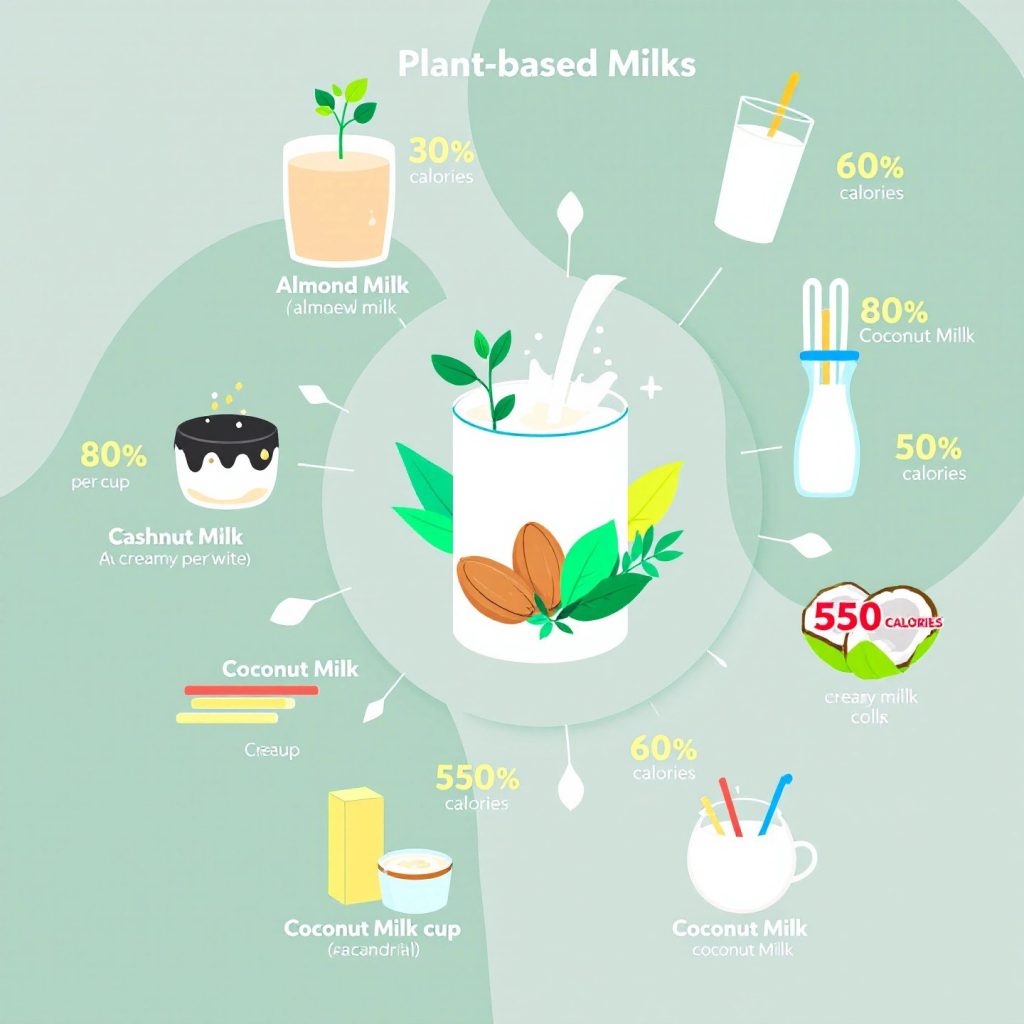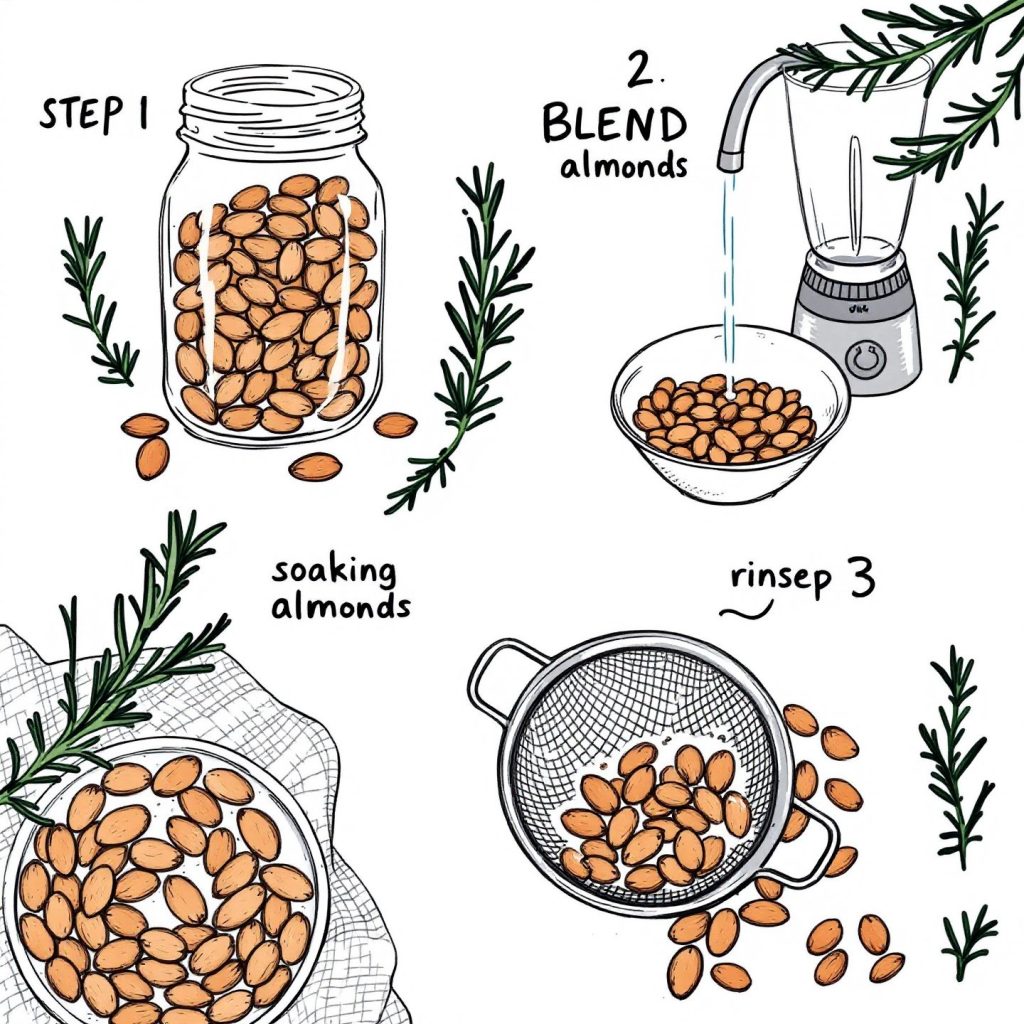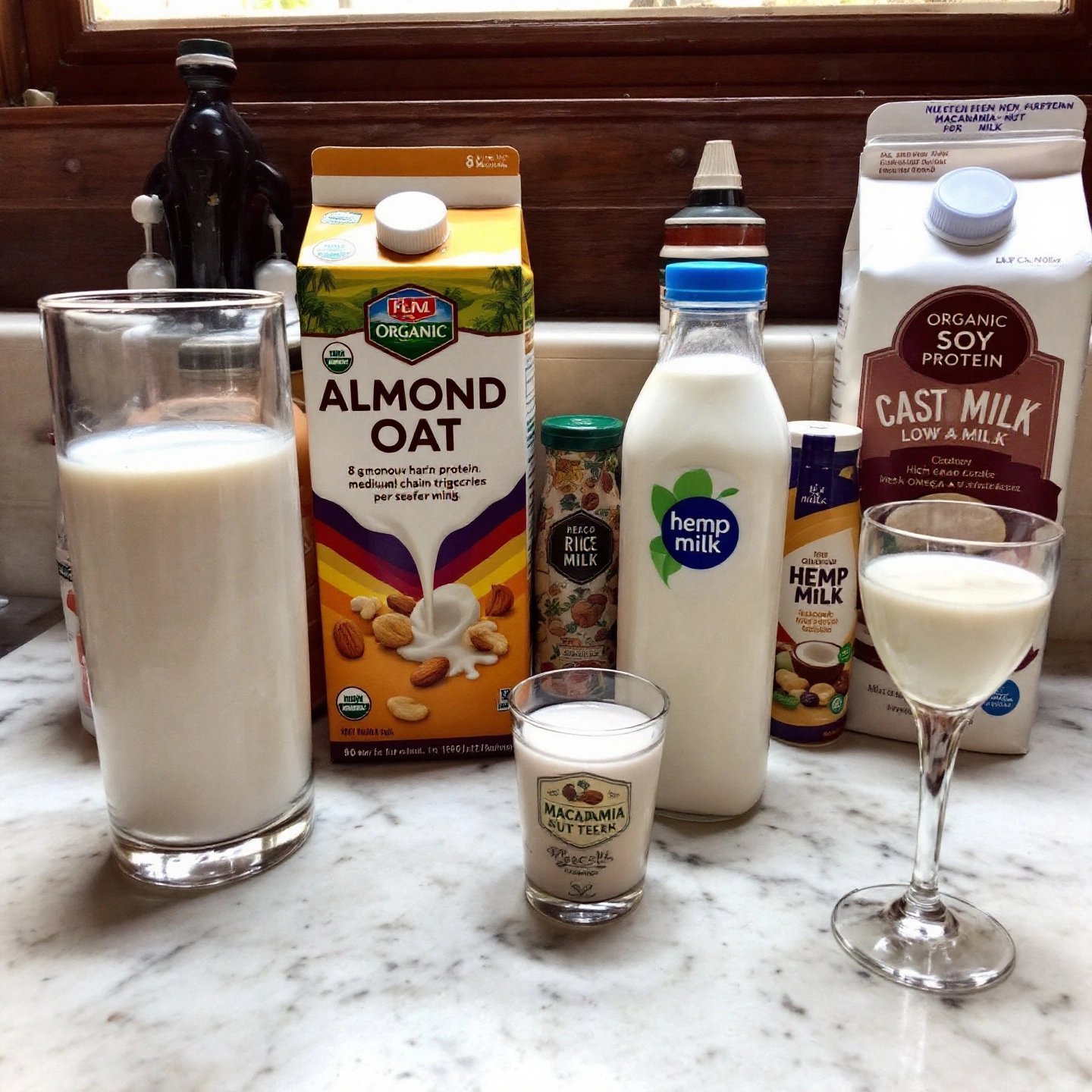Introduction: Understanding the Importance of Low-Calorie Milk Choices
In the quest for effective weight management, low-calorie milk options have become a focal point for many health-conscious individuals. As more people aim to reduce their calorie intake without sacrificing nutritional value, the interest in milk alternatives with fewer calories has surged. The type of milk you choose can significantly influence your daily calorie consumption and, consequently, your weight loss goals.
Different types of milk, ranging from traditional dairy to plant-based alternatives, offer varying calorie counts and nutritional profiles. For instance, whole milk is rich in calories and fat, while skim milk provides the same essential nutrients with a reduced calorie count. Similarly, plant-based milks such as almond or soy milk often offer lower calorie options, particularly in unsweetened forms. This diversity allows individuals to tailor their milk choices to align with personal dietary needs and weight management plans.
Making informed decisions about milk consumption is crucial for those focused on weight loss. By understanding the calorie content and nutritional benefits of different milk types, you can better integrate them into a balanced diet. This approach not only supports weight management but also ensures that you receive the necessary nutrients for overall health. As you navigate the myriad of milk options available, prioritizing low-calorie choices can be a strategic step toward achieving your weight loss objectives.

Calorie comparison of various dairy milk options (AI-generated)
Comparing Calorie Content: Dairy Milk Options
When considering dairy milk options, understanding their calorie content is crucial for those aiming to manage their weight effectively. Dairy milk comes in several varieties, each differing in fat content and, consequently, calorie count. Let’s delve into the calorie profiles of these options to help you make informed choices.
Whole Milk and Its Caloric Impact
Whole milk, often regarded as the most traditional form of dairy, contains about 150 calories per 8-ounce cup. This higher calorie count is primarily due to its fat content, which is approximately 3.25% milk fat. While it provides a rich source of protein and essential nutrients, its calorie density makes it less ideal for those on a calorie-restricted diet.
Reduced-Fat and Low-Fat Milks: A Middle Ground
Reduced-fat (2%) and low-fat (1%) milks offer a compromise between whole milk and skim milk, with 120 and 100 calories per cup, respectively. These options reduce fat content while still maintaining a good level of protein and calcium. They are suitable for individuals seeking to cut calories without entirely eliminating fat from their diet.
Skim Milk: The Low-Calorie Leader
Skim milk stands out as the lowest calorie option among dairy milks, with just 80 calories per cup. This is achieved by removing most of the milk fat, resulting in a beverage that retains the same levels of protein and calcium as its higher-fat counterparts. Despite its lower calorie count, it’s important to note the nutritional trade-offs, such as reduced levels of fat-soluble vitamins like E and K.
Choosing the right dairy milk depends on balancing calorie intake with nutritional needs. For those focused on minimizing calories, skim milk is often the preferred choice. However, understanding the nutritional trade-offs is key to making a decision that aligns with your health goals. As we transition to exploring plant-based alternatives, you’ll find even more options to support your weight management journey.

Calorie content of popular plant-based milk alternatives (AI-generated)
Plant-Based Milk Alternatives: Low-Calorie Champions
As the demand for dairy-free options continues to rise, plant-based milk alternatives have become popular among those seeking lower-calorie choices. These alternatives, made from a variety of nuts, grains, and seeds, offer a diverse range of flavors and nutritional profiles. Understanding their calorie content and nutritional benefits can help you select the best option for your weight loss goals.
Almond Milk: A Top Contender
Almond milk is a staple in the plant-based milk category, known for its mild, nutty flavor and low-calorie count. Unsweetened almond milk typically contains about 39 calories per cup, making it one of the lowest calorie options available (GoodRx). Despite its low calorie content, almond milk is low in protein, providing only 1 gram per serving. However, it is often fortified with calcium and vitamin D, making it a nutritious choice for those looking to reduce calorie intake.
Cashew Milk: Creamy and Low in Calories
Cashew milk offers a creamy texture similar to cow’s milk, with a slightly higher calorie count of about 130 calories per cup for unsweetened varieties. While it provides more fat than almond milk, it is still relatively low in calories compared to dairy options. Cashew milk is also low in protein and calcium, so it’s important to consider these factors when incorporating it into your diet (GoodRx).
Exploring Other Low-Calorie Plant Milks
Other plant-based milks, such as coconut and hemp milk, also offer low-calorie options. Unsweetened coconut milk contains about 46 calories per cup, while unsweetened hemp milk has about 60 calories per cup. These varieties provide different nutritional benefits, such as healthy fats in hemp milk, but may lack protein and calcium compared to dairy milk (NY Times).
When choosing plant-based milks for weight loss, unsweetened varieties are the best choice to avoid added sugars and extra calories. While these milks can be lower in calories, they may not provide the same protein and nutrient levels as dairy milk, so balancing them with other protein-rich foods is essential. As we delve into the nutritional considerations beyond calories, you’ll discover how to make these alternatives a valuable part of your diet.
Nutritional Considerations Beyond Calories
When selecting milk for weight loss, it’s essential to look beyond calorie content and consider other nutritional factors that can significantly impact your health. While low-calorie options are beneficial for reducing overall calorie intake, the nutritional value of milk alternatives plays a crucial role in maintaining a balanced diet.
Protein Content: A Key Factor
Protein is an essential nutrient that supports muscle maintenance and growth, which is vital for metabolism and weight management. Dairy milk, particularly skim and low-fat varieties, provides a robust source of high-quality protein, with approximately 8 grams per cup (Healthline). This makes it an excellent choice for those seeking low calorie high protein milk. In contrast, many plant-based milks, such as almond and cashew, offer significantly less protein, typically around 1 gram per cup, necessitating supplementation from other dietary sources.
Vitamin Fortification and Essential Nutrients
Milk, both dairy and plant-based, is often fortified with essential vitamins and minerals, contributing to overall health. Dairy milk naturally contains 13 essential nutrients, including calcium, vitamin D, and potassium, crucial for bone health and cardiovascular function (American Dairy Association). Many plant-based milks are fortified to match these nutrients, but the levels can vary, so it’s important to check labels to ensure you’re meeting your dietary needs.
Choosing milk with a balance of low calories and high nutritional value can aid weight loss while supporting overall well-being. As you consider your options, prioritize those that provide a comprehensive nutrient profile to help maintain health and vitality. In the next section, we’ll explore the best milk choices for achieving your weight loss goals.
Best Milk Choices for Weight Loss Goals
Choosing the right milk can be a strategic component of a weight loss plan. Whether you prefer dairy or plant-based options, selecting milks that align with your dietary goals can aid in reducing calorie intake while ensuring you receive essential nutrients.
Top Dairy Milk Options
For those who prefer dairy, skim milk is often the best choice for losing weight due to its low calorie content. With only about 80 calories per cup, skim milk provides a substantial amount of protein and calcium without the added fat found in whole or reduced-fat varieties. Low-fat milk is another viable option, offering a slightly creamier texture with around 100 calories per cup, making it a good middle ground for those who find skim milk too thin.
Plant-Based Alternatives
Among plant-based milks, unsweetened almond milk is a standout for its minimal calorie content—approximately 39 calories per cup—making it an excellent choice for those who are calorie-conscious. Similarly, unsweetened coconut milk, with about 46 calories per cup, offers a low-calorie option with a unique flavor profile. Soy milk, particularly the unsweetened variety, is another great option, providing about 80 calories per cup along with a decent protein content, which can help in maintaining satiety.
Incorporating Milk into Your Diet
Integrating these low-calorie milk options into your diet can be both simple and versatile. Use skim or almond milk in your morning coffee or cereal to start your day with fewer calories. In cooking, replace cream with low-fat milk in soups and sauces to cut down on fat while maintaining flavor and texture. For baking, plant-based milks like almond or coconut can substitute for dairy milk, providing a lighter alternative that complements various recipes.
By thoughtfully incorporating these milk choices into your meals, you can effectively manage your calorie intake without sacrificing taste or nutrition. As you explore these options, remember that balance is key—pairing low-calorie milk with a diverse range of foods will support your weight loss journey while ensuring a well-rounded diet.
Potential Pitfalls: Hidden Calories and Additives
While choosing low-calorie milk options is a smart strategy for weight management, it’s crucial to be aware of hidden calories in some milk varieties. Flavored or sweetened milks, whether dairy or plant-based, often contain added sugars and other ingredients that can significantly increase their calorie content. For instance, chocolate or vanilla-flavored milks can contain up to 20 grams of sugar per serving, adding unnecessary calories that can derail your weight loss efforts.
Understanding Additives in Milk Alternatives
Milk alternatives, such as almond or soy milk, may also contain additives like thickeners and stabilizers, which can contribute to their calorie count. Ingredients such as carrageenan, guar gum, and xanthan gum are commonly used to enhance texture and shelf life but can sometimes add calories or affect digestion. It’s important to choose unsweetened versions whenever possible to minimize these hidden calories.
Reading Milk Nutrition Labels
To effectively manage your calorie intake, developing the habit of reading milk nutrition labels is essential. Look for products with minimal added sugars and check the ingredient list for unnecessary additives. The nutrition label provides valuable information about the calorie content, serving size, and nutrient profile, helping you to make informed choices. According to Michigan State University Extension, being aware of serving sizes is crucial, as consuming more than the indicated amount can lead to consuming more calories than anticipated.
By being vigilant about hidden calories in milk and milk alternatives, you can avoid common pitfalls that may hinder your weight loss goals. As you continue to explore various milk options, keep an eye on labels and prioritize those that align with your nutritional needs. This awareness will empower you to make healthier choices, ensuring your milk selection supports your overall dietary objectives. Next, we will explore how making your own low-calorie milk at home can offer even more control over what you consume.

Steps to make homemade low-calorie almond milk (AI-generated)
Making Your Own Low-Calorie Milk at Home
For those looking to control calorie content and customize their milk ingredients, making homemade plant-based milk can be an excellent solution. Not only does this allow you to tailor the flavor and sweetness to your liking, but it also ensures that no unnecessary additives or preservatives sneak into your diet. Plus, creating your own milk at home can be surprisingly simple and rewarding.
DIY Almond Milk: A Simple Recipe
To make your own almond milk, you’ll need just a few ingredients: almonds, water, and any optional flavorings like vanilla or a sweetener of your choice. Start by soaking one cup of almonds in water overnight. After draining and rinsing the almonds, blend them with four cups of fresh water until smooth. Strain the mixture through a nut milk bag or cheesecloth to remove the pulp, and voilà—fresh almond milk! This process not only gives you control over the calorie content but also allows you to experiment with flavors and thickness (Minimalist Baker).
The Benefits of a Plant Milk Maker
While making plant milk manually is straightforward, using a plant milk maker can streamline the process, providing consistency and convenience. These devices are designed to blend and strain the milk, reducing preparation time and effort. For those who frequently consume plant-based milk, investing in a plant milk maker can be a game-changer, ensuring a steady supply of fresh, homemade milk with minimal hassle. For more on plant milk makers, explore the top plant milk makers of 2025, which offer health benefits and eco-friendly choices.
By crafting your own low-calorie milk at home, you gain complete control over the ingredients and nutritional content, making it easier to align with your weight management goals. As we conclude this guide, remember that experimenting with different recipes and tools can lead to discovering the perfect milk option that suits your dietary needs and preferences.
Conclusion: Choosing the Right Low-Calorie Milk for You
As we’ve explored throughout this guide, selecting the right low-calorie milk involves understanding the diverse options available and how they align with your weight management goals. Whether you opt for dairy or plant-based alternatives, the key is to find a balance between calorie content and nutritional value that suits your personal preferences and dietary needs.
Choosing low-calorie milk is not just about cutting calories; it’s about making informed decisions that support your overall health. Consider factors such as protein content, vitamin fortification, and any dietary restrictions you may have. For instance, skim milk and unsweetened almond milk are excellent choices for those seeking to minimize calorie intake while still ensuring adequate nutrition.
Experimenting with different milk options allows you to tailor your diet to what works best for you. This personalized approach ensures that you enjoy your meals while staying on track with your weight loss objectives. Moreover, making your own plant-based milk at home can provide ultimate control over calorie content and ingredients, offering a customizable and eco-friendly option for the health-conscious consumer. For those interested in this DIY approach, consider exploring the top plant milk makers of 2025 for added convenience and efficiency.
Ultimately, the right choice of milk is one that aligns with your lifestyle and health goals. By staying informed and open to trying new options, you can find the perfect milk to complement your weight management journey.
In case you’re specifically searching for the lowest calorie nut milk, a low calorie milk alternative, or the lowest calorie milk option, it’s important to note that no truly 0 calorie milk exists. Many people also ask which milk has the least calories or what milk has the least calories, but even the lowest cal milk or the least fattening milk still contains some amount of calories. Skim milk can be considered a low calorie high protein milk, while unsweetened almond milk is often hailed as the lowest calorie plant milk or lowest calorie non dairy milk. For coffee lovers, seeking the lowest calorie milk for coffee or a low calorie milk for coffee can help manage calorie intake without sacrificing flavor.
Some individuals wonder what milk is lowest in calories or how to find the healthiest milk to lose weight, often comparing calories in different milks to see which milk has less calories overall. If you’re looking for the lowest calorie alternative milk or a low calorie milk substitute, unsweetened almond or soy milk are excellent picks—though the idea of zero calorie milk is generally a myth. In reality, there’s no milk with the least calories that is completely calorie-free, but you can discover low calorie milks by reading labels diligently. For those seeking the best milk substitute for weight loss or specifically a high protein low calorie milk, skim milk or unsweetened soy milk may be your go-to. You can also find low fat milk alternatives if you’re aiming to cut down on fat intake, or discover the lowest calorie milk substitute for specialized diets. Moreover, if you have concerns about sugar, consider what milk has the least sugar and always opt for unsweetened varieties. Finally, remember that even the lowest fat milk or milk low calorie options should be part of a balanced diet.
Frequently Asked Questions
1. Which milk is healthy for weight loss?
Unsweetened almond milk is often recommended for weight loss due to its low calorie content and ability to fit into a low-carb diet. Skim milk is also a good option for those preferring dairy, offering low calories and high protein.
2. Does almond milk or oat milk have less calories?
Almond milk generally has fewer calories than oat milk, with unsweetened almond milk containing about 39 calories per cup compared to oat milk’s 120 calories per serving, making almond milk a better choice for calorie reduction.
3. Does skim milk or almond milk have less calories?
Unsweetened almond milk typically has fewer calories than skim milk, with about 39 calories per cup compared to skim milk’s 80 calories, making it a lower-calorie option for those seeking to reduce intake.
4. Is there a downside to almond milk?
While almond milk is low in calories, it is also low in protein compared to dairy milk. Some varieties may contain added sugars or thickeners, so choosing unsweetened versions is advisable.
5. How can I make low-calorie milk at home?
You can make low-calorie almond milk at home by blending soaked almonds with water and straining the mixture. Using a plant milk maker can simplify the process and ensure consistent quality.
